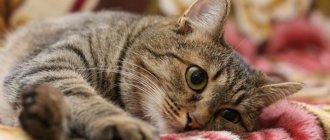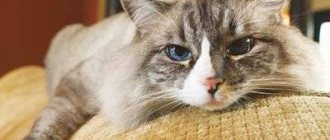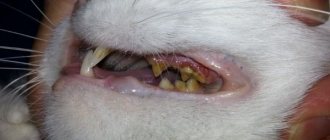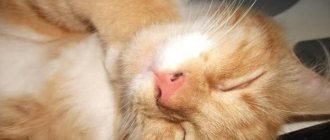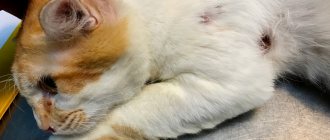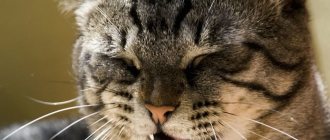Injuries
Domestic cats experience fewer injuries, since there are many risks on the street in the form of fights with relatives or other animals. If the injury is severe (for example, after a fall from a height), the pet may shake its head for a while and lean to one side. If this condition does not go away within 24 hours, it is recommended to immediately take him to the nearest veterinary clinic. To make a diagnosis, it will be necessary to exclude injuries to the skull, cervical spine, and concussion. Injuries can also include insect bites, after which the cat not only shakes its head, but also rushes around the house. We are talking about wasp and bee stings in the area of the nose, lips, ears and eyes. The bite site always swells and turns red. It is recommended to immediately give your pet an antihistamine (Fenistil, Cetirizine).
The cat is shaking after sterilization: how to distinguish between normal and pathological (by day)
In most cases, a cat shakes after sterilization for quite “valid” reasons: its body seeks to warm up, for which it burns excess reserves (in the form of liver glycogen and subcutaneous fatty tissue). But still, in some situations, the animal must be shown to a veterinarian as quickly as possible, since otherwise serious postoperative complications may develop (including severe hypothermia). To do this, you need to know which behavior is normal for a cat, and which is a reason for an early visit to the veterinarian.
How to understand a cat by its tail?
A long flexible whip or a fluffy fox tail - any tail is undoubtedly the most noticeable “decoration” of a cat. But Nature, a tireless dreamer and a brilliant scientist rolled into one, probably endowed animals with this part of the skeleton for a reason. Let's figure out why a cat needs a tail and how mustachioed impatiens use this valuable gift of evolution.
What is a tail?
A cat's spine consists of the cervical, thoracic, lumbar and sacral regions - sounds familiar, doesn't it? But then we see the differences between humans and cats: where our coccygeal part is located, in cats the tail begins - another part of the spine. The structure of a cat's tail is quite simple: the first and largest vertebra is connected to the sacrum, the next vertebrae become thinner and shorter, and so on until the last, very small vertebra at the tip of the tail.
Normally, there are joint spaces between the vertebrae that are filled with a jelly-like substance that acts as a lubricant - this is why cats wag their tail in any direction, and can bend their tail up or sideways without risking injury or experiencing discomfort.
The number of vertebrae is from 20 to 27, the length of the tail is from 20 to 40 cm. The Siamese cat waves its long and thin tail, because it itself is a slender and elongated athlete. The Persian lady is square in size, dense and stocky, boasting a thick and short tail. Such harmony is obvious and necessary, because one of the reasons why cats wave their tail is an attempt to maintain balance.
Tail and balancing
“He’s like a cat: no matter what happens, he always lands on four paws,” they say about a person who will find a way out of the most difficult situation. Scientists around the world are closely studying this ability of cats and even applying the acquired knowledge in areas related to the study of aerodynamics. B
Source
Reasons why a cat walks after sterilization
The reasons why a cat asks for a cat may be as follows:
- poor quality operation. Due to the negligence and inexperience of the veterinarian, not all ovaries were removed; hormone production continues.
- In a cat’s body, hormones can be produced not only in the ovary. Sometimes the cause of estrus is substances synthesized by the adrenal glands or pituitary gland. As a rule, this is typical for young individuals.
- ectopic ovarian tissue syndrome. When the genital organs form in the womb of a pregnant mother, some cells enter another part of the animal's body. It is almost impossible to identify such a pathology. Fortunately, such heredity is very rare, but is possible in any breed, including Scottish Folds.
Pay attention to me
When a pet walks and screams for no apparent reason, it is most likely just attracting attention. Cats understand well that their owner will react to their cry.
Often in this way they beg for a treat or food when they are hungry, and when they are not hungry either.
Most pets spend the entire day alone and lack affection and attention. With a cry, the cat asks to be played with, stroked, and given time.
Calm the cat down, play with it, talk to it, give it something tasty, let the pet feel your love and care. Spend more time with your cat, buy new toys more often. Perhaps then the pet will forget that you need to wake you up at night with its loud screams.
Other cat signals
An animal's eyes are an important tool for expressing its emotions towards a person.
Cats show emotions by:
- torso;
- tail;
- eyes;
- ears;
- head;
- mouth.
Experienced breeders say that a sitting kitten with a wagging tail expresses a playful mood. He feels especially good when, when stroking, he lifts his butt up, sticks his butt out, presses his ears back and squints his eyes. To invite a person to play with him, the cat may start swinging on the floor. But such a reaction may also be evidence that the cat has overate or been poisoned. Then he screams more often and jerks the back of his body away from touch. Before jumping, the pet often sits down, presses itself to the floor and begins to wag its butt, so it aims for a more accurate landing.
If while walking the pet begins to trample, this indicates that the kitten is preparing a place for sleep and is going to lie down there. When cats sit and protrude their eyes, they are trying to catch the smallest changes in the world. If a pet sits peacefully on its butt, then a person begins to stroke it and the beloved animal fights and bites without biting the skin - this is just the furry’s desire to play, this is how he behaves with his relatives.
Vestibular ataxia
The diagnosis is made in two cases: with an affected structure of the inner ear and with tumors of the brain stem or medulla oblongata. Adult animals over 10 years of age are most susceptible to the disease. The cat has difficulty standing, can walk in circles, or fall over on one side.
The head is either thrown back or tilted towards the affected side. Movements are slow and careful. Concomitant strabismus and nystagmus are often found, and in some cases there is also periodic vomiting.
The appearance of vestibular ataxia is provoked by:
- otitis;
- brain tumors;
- bacterial infections and abscesses of the ear canal;
- excessively intense and traumatic ear cleaning;
- medication overdose;
- use of aminoglycoside antibiotics;
- liver or kidney dysfunction (in rare cases).
Why does a cat meow for no reason?
Domestic cats are rarely silent all the time. They make sounds that signal the owner about a particular state, and also show their mood at the moment. Cats can purr, meow affectionately, or scream furiously
At this moment, it is especially important not to shout at the animal and not to hit it under any circumstances, but to try to figure out what could provoke such behavior
It cannot be that a cat meows for no reason. There is always a factor that provokes an animal to make characteristic sounds.
By meowing, the cat tries to get attention or actively indicates that it is not full. Sometimes, a cat's meowing indicates that the pet is experiencing discomfort.
In addition to the sounds made by the cat, additional symptoms arise - anxiety, aggression, depression.
The owner can try to identify the cause of stress or discomfort himself, but the best solution would be to consult a veterinarian.
Reasons for the reaction
The animal uses various body movements to communicate with the outside world. When a person begins to stroke him and the kitten puts his butt up, purrs, crawls closer to the owner and looks with narrowed eyes - this is the highest degree of pleasure for the pet from stroking. In this way he shows that he likes the affection, he asks to continue. Often, the cat raises his tail - this is his natural property to invite him to sniff the anus. This is how animals show attention to each other when the individuals are pleasant to each other and not annoying. If you pet a cat, and he spins around, meows, presses himself to the floor, lifts his tail and wags it, the animal does not like the affection and is irritated.
The cat sticks out its butt when stroking it when it indicates a high degree of emotional delight and pleasure.
Behavioral disorders
Cats are vindictive and can take good revenge on their offenders. In fairness, it should be mentioned that they also remember good things very well. If an animal is often offended, poked, not caressed, not paid attention to, or driven away, you should not be surprised that it begins to take action. And he has only three methods of revenge available to him:
- shitting or urinating in the most inappropriate place;
- bite or scratch a careless or evil owner;
- prevent owners from living in peace, annoying them with loud and unpleasant screams day and night.
Basically, this behavior is characteristic of cats that have gone through cruelty and neglect of their owners. Even if they have a different, kind and affectionate owner, they will not immediately overcome their character. It will take a lot of time and effort to regain your pet's trust, pacify his temper and get rid of constant howling and whining.
Cats raise their butts when you pet them, and this is how they communicate with their owner.
Dogs, for example, when getting to know each other, will definitely sniff each other’s tails. Cats will first sniff each other’s faces, and if they then offer to sniff each other’s tails, this is a sure sign of friendship and the fact that one animal is confident in the good intentions of the other. And if a person strokes a cat, and she raises her butt, it means she considers him her friend.
Stroking a cat can be accompanied not only by protruding its butt - it can roll over onto its back, exposing its tummy, roll over and purr. All these body movements indicate that the pet likes everything, he is calm and feels safe.
Various types of body movements for animals are a way to communicate with the outside world. Kittens learn to communicate with each other and with their mother from birth, and then, when they become someone’s pet, they begin to treat their owner in many ways like their mother.
If an animal, while playing, begins to bite slightly, you should not be offended by it for this - this element simply accompanies the cat’s playfulness.
The kitten stopped eating for the second day, when you pick it up it meows, what’s wrong with it?
The day before yesterday we put anti-scratch pads on the kitten (4 months old), and last night he stopped eating. He drinks water and plays. But more often he began to lie down and sleep and follow me. Sometimes he meows..
We recommend reading: Dog Poisoning with Salt
They gave me chicken and porridge and fish, and he would bite a little and go away and meow. I’ve always eaten premium food, but I haven’t touched it for two days now.
It looks like he's missing someone. This happens when kittens are separated from those they love: they eat less, sleep more and are less active. And some even stop playing. They meow and walk around the apartment - looking for someone they miss. (This also applies to your question about the bowl) I think that the reason is that someone is missing from the apartment or house (perhaps this someone used to feed your pet, played with it, etc.), but has left somewhere .
The cat meows to be called: In response You need to answer him: Kitty-kitty, until he comes running. Take him in your arms and stroke him, give him something tasty (from your hand) - he gets lonely.
Usually this exceeds the first days (when the kitten is torn away from his mother and brothers - he is looking for them); If the owner or someone close to your pet leaves somewhere, as well as if another pet has died or disappeared (another cat, mine are friends with a dog, for example), and your kitten was friends and played with this animal (even if the toy disappeared, this happens).
An animal is not a person, it doesn’t go to the doctor, it has instinct. And instinct says that in case of any problems, the animal stops eating so that the body can use the released energy to solve these problems, to restore the body. It is also advisable for a person to do exactly this. There are no diseases that cannot be cured with hunger. A good appetite is a sign of health and the absence of other problems. If the kitten has no visible symptoms of illness, then it may have mental problems, since it is still
Source
Treatment Options
Treatment depends on the degree of development of the pathology. The doctor can choose both conservative and surgical treatment methods. Veterinarians resort to surgery only if it is impossible to do without it.
Conservative way
The conservative method is suitable if not much time has passed since the loss.
To begin with, the animal is given sacral anesthesia or anesthesia is administered. Next, the doctor treats the prolapsed part of the intestine using a special solution. The intestine is lubricated with ointment. The doctor puts on gloves and gently sets the intestine with his finger.
After this, to avoid repeated prolapse, a purse-string suture is placed on the anus. It will not interfere with the passage of feces, but at the same time will keep the inflamed intestine in place.
Upon returning home, the cat will need to have anal suppositories placed for several days. The suture is removed 3-5 days after reduction.
If frequent relapses occur, some sections of the large intestine are sutured to the abdominal cavity.
You might be interested in: What causes black spots on a cat's chin?
Surgery
If the prolapsed section of the intestine has become infected and tissue necrosis has begun, the animal undergoes surgery and the dying tissue is removed. Most often this happens in cases where the owner does not take the animal to the doctor immediately after the problem occurs.
If infected tissue is not removed, sepsis may soon occur and the animal will die. Also, indications for surgery are frequent relapses of rectal prolapse, or the inability to straighten the intestine using a conservative method.
The animal is given general anesthesia. The animal should not be fed 12-24 hours before. Only water can be given.
During the operation, the doctor cuts off the infected tissue, and the rest of the intestine is sutured to the anus. Surgical intervention is carried out only in the clinic - under sterile conditions.
There are the following methods of performing the operation:
- Frick's method. Most often practiced by surgeons. Using a needle, two ligatures (special threads that are used to ligate blood vessels) are inserted slightly away from the anus. The intestine is cut off with a scalpel at a distance of 1 cm from them. The ligatures are crossed, resulting in the formation of 4 knots. The ends of the ligatures are moved slightly to the side, and sutures are placed on the intestine. Next, the ends of the ligatures are cut off and the intestine is straightened.
- Minkin's method. Based on the Frick method, but simplifies the removal of ligatures. To do this, the surgeon uses a straight needle and tweezers.
- Olivekov's method. The prolapsed part of the intestine is pierced with mandrels. Care should be taken not to rupture the hemorrhoidal vessels. The intestines are straightened. The incision is made at a distance of 1 cm from the mandrels. Bleeding vessels are tied up, mandrels are removed, and the intestine is sutured. The intestine is inserted into the anus.
- Resection using a test tube. A glass test tube is inserted into the tubular intestine. The intestine is corrected and stretched. Next, one incision is made and several stitches are immediately applied to close the bleeding vessels. Next, incisions and sutures alternate until the entire intestine is cut off.
As a result of the operation, the following complications may occur:
- allergic reaction to medications or suture material;
- inflammation of the intestine;
- improper placement of sutures, which causes a narrowing of the anus;
- problems with bowel movements.
Postoperative care
After the operation, the animal will have to treat the anus with antiseptics and special ointments. Rectal suppositories may be prescribed.
In order to maintain hygiene, the cat should wear a special diaper. The animal must be kept in a clean, warm and dry place.
The cat needs to be protected from stress. Strong physical activity is also undesirable. The animal should rest more.
After surgery, the cat must be on a diet for some time. Dry food should be excluded from the diet. Food should be low-fat and easily digestible. It is important to avoid the formation of gases and constipation in the animal.
The cat should be fed 3-4 times a day in small portions. You can switch to your usual diet gradually, after the postoperative wound has completely healed.
After the intestine has been set in place, you should begin to eliminate the cause that led to the prolapse. If this happened due to infection with worms, it is necessary to rid the animal of parasites.
If the cause is chronic diseases, inflammations and pathologies, it is necessary to treat them. If the problem is not resolved, bowel prolapse may recur.
Types of ataxia
Depending on the area of damage, there are two main types of pathology.
Sensitive ataxia (proprioceptive)
This form of the disease occurs due to damage to the spinal cord or peripheral nerves. The occurrence of the disorder may be influenced by the presence of a tumor in the intervertebral discs in the cat.
The animal loses the ability to flex and extend its paws at the joints. It cannot consciously choose the direction of its movement. The cat is experiencing severe pain in the back and neck. In severe forms of the pathology, the cat cannot move completely.
Attention! If the brain is only partially damaged, and treatment was prescribed at an early stage, the pet has a chance of a full recovery
Vestibular ataxia
The diagnosis of vestibular ataxia is made if the inner ear system is affected and there is also a tumor of the brain stem. Pets over ten years of age most often get sick. The cat cannot stand, it falls on its side. The head tilts towards the affected side
The animal moves very slowly and carefully. Vomiting is sometimes observed
Vestibular ataxia can occur due to:
- development of a brain tumor;
- otitis media;
- infections;
- injuries when cleaning ears;
- drug overdose.
Important! The first sign of pathology is that the cat is sitting in the corner, leaning its forehead against the wall.
General symptoms
In addition to individual signs of the disease, characteristic only of one of its forms, there are several general symptoms by which ataxia can be identified:
- The cat has a wobbling gait with drifts to the side.
- When walking, the paws are widely spaced; The animal seems to be constantly afraid of falling.
- Often falls while walking or running.
- Rarely holds head straight; more often - with an inclination to the side or down.
- Does not control her body: even with fairly confident walking, she is not able to jump, go down/ascend, or turn around a turn.
- In severe cases, he cannot consistently perform the simplest movements. Remains in one place, but wobbles a lot and falls.
- Partially or completely not oriented in space. Bumps into objects and does not know how to calculate real distance.
Signs of aggression in cats
Before “going berserk,” your pet gives clear signals about an upcoming burst of aggression. How to determine that an animal is preparing to attack:
- angry grin;
- growling and hissing;
- mustaches and ears are pressed down;
- dilated pupils;
- wool standing on end;
- a crooked, awkward pose;
- looking directly at the target or clearly avoiding eye contact.
Cry from the heart
The cat looks angry, irritated, on edge, as if he is unable to relax, and explodes at the slightest provocation. Almost anything can provoke such a release of negativity - from the fright of an awakened animal to serious changes in the environment or place of residence. For example, it is almost guaranteed that a cat will “go mad” when there are a large number of strangers, the appearance of a new pet, or when moving frequently.
Aggression can be intraspecific (cat-cat) and interspecific (cat-another animal, cat-human). Also, sometimes the pet attacks and tears objects.
Sometimes the pet attacks and tears objects
Animal psychologists say: signs of aggression in cats very often mask fear and severe stress in which the animal itself is. The cat wants to, but cannot find a way out of the situation and understand it. He can be helped by simply understanding what led to the aggression.
People around you and the cat itself suffer from unsatisfied natural needs of the body.
An inexperienced owner may not immediately understand that his pet is in heat.
A number of signs confirm this condition:
- Swollen genitals, clear fluid oozing.
- Reducing the time between urinations.
- Constant meowing, the cat instinctively calls for a male.
- Loss of appetite.
- The desire to run out of the house. Owners must keep windows and doors closed.
- Change in emotional state: increased affection (the animal caresses people, rubs against furniture) or uncontrollable aggressiveness (scratches, bites).
- Typical movements: arching the back, stomping with the hind legs, pressing the tail to the side.
After making sure that the cat is going through a period of sexual activity, you should take measures to alleviate the pet’s condition.
The first signs of sexual desire in a pet can be observed as early as 6-7 months of age. These signs are manifested as follows:
- Loud scream and purring of a cat.
- The appearance of marks throughout the home, which the cat makes during estrus, when she begins to have copious discharge.
- While the cat is walking, she stands in certain positions, which indicates a desire to mate with the cat. So, she begins to lower herself onto her front paws, while her croup will be raised and her tail will be moved to the side.
- The animal may not eat well or completely lose its appetite.
- Frequent urination, uncharacteristic of the usual condition.
- The most obvious sign that a cat is asking for a cat is its excessive affection. She will constantly curl around her owner's feet, the legs of tables, chairs and other objects, and purr loudly. There are times when an animal expresses its desire through aggression.
During the period of heat, the cat begins to meow constantly
Proestrus
The onset of estrus, or its first stage, lasts 1-2 days and can be noticed by the owner by the cat's more restless behavior. The most subtle indicator of this stage is the cat. You may notice that the cat has a slightly enlarged and moist vulva. Increased appetite and restlessness are also noted. She makes low, guttural cries and fawns on her owner more than usual. She is attractive to cats, but does not yet allow them to approach her. Proestrus is characterized by a period of courtship, during which the very presence of a cat nearby stimulates the activation of hormone secretions in the cat, which leads her to a real estrus.
- Signs of estrus in cats
- Signs of estrus in cats
Pathological causes of tremor
The reason why the cat is trembling as if he is cold, although he is at home in comfortable conditions, may be pathological factors. In this case, tremor is often accompanied by the following clinical symptoms:
- photophobia;
- inactivity and lethargy;
- aggression;
- pain syndrome;
- increased body temperature;
- diarrhea or constipation;
- vomit;
- purulent discharge from the nasal cavity or eyes;
- impaired coordination of movements.
Often, the presence of pathology in a cat is indicated by trembling of individual parts of the body or muscle groups, when only the head, front or hind limbs shake.
There are many pathological reasons why kittens and adults tremble.
A deficiency of calcium and B vitamins in the body provokes degenerative processes in muscle tissue in cats.
The reason that the kitten is trembling may be infectious rhinotracheitis. In addition to tremor, this disease is accompanied by cough, purulent discharge from the eyes and nose, a significant increase in body temperature and digestive disorders.
With the development of helminthic infestations, when helminths clog the pet's intestines and release a huge amount of toxic products of their vital activity, the kitten experiences symptoms of intoxication, it becomes lethargic and trembles all over its body.
The body's response to the introduction of general anesthesia. If the cat shakes for more than 6 hours after surgery, this may indicate the development of internal bleeding. In this case, urgent medical intervention is necessary.
Body tremors in cats are provoked by acute inflammatory processes in the organs of the genitourinary system and attacks of urolithiasis.
Otitis media, caused by ear mites or other factors, leads to frequent head twitching. The cat scratches the sore ear, hits it, tilts its head towards the affected organ. As a result, scratches and hematomas appear in the ear area. Lack of treatment leads to inflammation spreading to the inner ear and meninges, which provokes death.
During acute liver failure, the cat develops vomiting and diarrhea; at the initial stage, it trembles slightly, and at the stage of failure of the affected organ, it trembles all over.
Head tremor may indicate traumatic brain injury, encephalitis, cerebellar lesions, or drug overdose.
If a kitten walks poorly and his whole body shakes, this may indicate spinal column injuries caused by congenital pathologies, compression or bruises. In adult cats, such symptoms are the result not only of injury, but also the development of tumors or deformation of the intervertebral discs.
If a kitten suddenly becomes lethargic, begins to tremble, first slightly, and then with increasing amplitude, then such tremors and lethargy most often indicate poisoning. If the baby is not taken to the clinic, he will develop seizures and die.
The cause of tremor may be borreliosis, which occurs after a tick bite. The insidiousness of the disease lies in its long latent period, when clinical signs may appear several months after infection.
Tremor combined with lethargy may be one of the signs of toxoplasmosis in cats.
If a kitten walks poorly, shakes, spins in place, or is poorly oriented in space, this may indicate that he has such a serious congenital pathology as hydrocephalus.
Tremors of the limbs, turning into convulsions, can occur in a cat during childbirth or within a week after it. This phenomenon is called eclampsia. It indicates an acute lack of calcium in the animal’s body. If left untreated, your cat will develop seizures, which can be fatal.
Causes of intestinal prolapse in cats
There are many reasons that lead to rectal prolapse. Some of them can only be diagnosed by a veterinarian after examining the animal. Most often, rectal prolapse is associated with gastrointestinal problems.
There are several reasons why rectal prolapse occurs:
- Frequent constipation. The animal strongly strains its muscles during defecation, which leads to disruption of their tone. In addition, too hard feces injure the intestinal walls, its walls become inflamed.
- Diarrhea. Severe diarrhea leads to intestinal inflammation. Frequent bowel movements lead to decreased muscle tone.
- Poor nutrition. There are two diet options: feeding with natural and industrial feed. Animals that eat prepared foods are more prone to rectal prolapse. There may be two reasons: - low quality feed, which leads to disruption of the gastrointestinal tract; - lack of fluid in the pet’s diet, which causes the stool to become too hard.
- Infection with worms. Parasitic infestation is most dangerous for young animals, because their immunity is not yet fully developed. Worms release their metabolic products into the host's body. This leads to intoxication of the body. The gastrointestinal tract becomes inflamed and ceases to function normally.
- Disruption of the reproductive system. In cats, prostatitis or prostate adenoma can lead to rectal prolapse. Inflammation of the reproductive system leads to disruption of the intestines. In cats, rectal prolapse often occurs during difficult births.
- Chronic diseases of the intestinal tract (proctitis, colitis). Inflammation of the intestines leads to weakening of the muscle tone of the anus.
- Neoplasms in the intestines and the presence of foreign bodies in the preanal area.
- Injuries. One bad fall from a kitten can lead to rectal prolapse.
- Injuries and neoplasms in the spinal cord.
- Cystitis. If your cat urinates frequently, he will also tense his anus in the process. Muscle tone decreases and the intestines become inflamed.
You may be interested in: The cat began to sneeze frequently: causes and dangerous symptoms
Most often, this problem occurs in kittens up to six months old, as well as in old animals that are more than ten years old. A predisposition to rectal prolapse is not inherited.
At what age does a cat start asking for a cat?
Puberty of a furry pet ends with the first heat. For everyone, this happens at its own time, but, as a rule, before the age of one.
That’s when it’s hard for the owner not to understand what’s going on. With the first heat, there comes a period when this behavior will occur regularly. There are a number of signs that make it clear that a person wants a cat for the first time.
- She screams shrilly. This is where natural instincts come into play, and you can’t go against nature. Wild cats call their partners with loud, heart-rending cries, indicating that they are ready to mate.
- Leaves marks everywhere. Estrus is always accompanied by discharge, which involuntarily remains where the pet has been. This is also inherent in nature to attract a male.
- There is a decrease in appetite or its complete absence only in conjunction with the above symptoms.
- Poses characteristic of mating. The cat raises her hindquarters and withdraws her tail, calling for a male.
- A pet asking for a cat becomes especially affectionate, can follow on the heels of the owner, rub against his legs, while raising her tail. However, all cats have different personalities, and this is reflected in their behavior during heat; your cute pet can become wild and aggressive.
Cat cycle length
When asked about the duration of the period when she asks the cat, characteristically raising her hind end, not a single veterinarian can answer accurately.
Many owners do not want to let their cat outside or bring in a male for mating. Everyone knows what consequences this leads to - several months of the whims of a pregnant cat, childbirth and caring for kittens. In addition, she can go for walks often: every 3-4 weeks. If such prospects do not inspire optimism, then sterilization measures should be taken or drugs that extinguish sexual instincts should be given.
Sterilization
Medicine does not stand still in “animal” matters. Here contraceptive methods come to the rescue of owners, allowing a cat to mate without bearing offspring; some owners choose them. Sterilization is the best option if you don’t want to watch her lift her hindquarters, you don’t need kittens and the pet’s periodic heart-rending screams.
Although a neutered cat will raise her hind end, this is an instinct. Previously, it was believed that it was better to let her give birth for the first time before surgery. But veterinarians have a different opinion: sterilize before birth.
Medicines
If you are against surgery, but listening to the cat's cries and seeing how the back end lifts is tiring, contact your pharmacists. In “cat” pharmacies you will find a number of drugs that will calm your pet’s sexual instincts. However, they should not be used frequently; consult your doctor regarding dosage and frequency.
The question remains: why does a cat lift his hindquarters? There is only one answer to it - strong sexual arousal. He can lean on his hind legs and lower himself onto his front legs. Try giving him sedatives as well.
Source
Can a cat ask a cat?
Can a cat walk after sterilization? is one of the most common questions veterinarians are asked after a procedure. The answer is yes. You can understand that your pet is asking for a cat by the following signs:
- arches his back, sticking out his butt;
- tramples;
- meows loudly.
Most often, a sterilized adult cat asks the cat to do this. Determining that a male wants a female is a little easier. He marks the territory and everything becomes clear by the smell.
For reference! Often, owners are also interested in whether the cat can walk already during pregnancy. The answer to the question is yes, females often look for a cat even after fertilization.
Treatment of ataxia in cats
In the case of a genetic cause, only death is possible. Most often, veterinarians offer timely care without waiting for complications to occur (constant headaches, attacks with loss of consciousness, spasms, inability to feed independently).
If the cause is traumatic or tumor, then the chances of a long life are more realistic and largely depend on early diagnosis. Most often, antispasmodic and sedative drugs and B vitamins are prescribed. Surgical intervention is possible.
It should be remembered that even in case of recovery, the cat will no longer be the same, since brain injuries never go away without a trace, and the owner needs to be prepared for the fact that the animal may be left with limited capabilities.
Mother's Call
When kittens are separated from their mother, they experience severe stress. After all, a mother is a means of calm, protection, safety and immune support for babies.
At first, cat cubs simply do not know how to behave without their mother and suffer from the lack of her warmth. They're scared. It is during this period that they meow, greatly in need of the care of the mother cat. During the period of adaptation to the owner, such crying may not subside at all for hours. What should the owner do in such a situation?
You need to be patient and take maximum care of the baby. Take him in your arms, stroke him, talk to him, hold him close and warm him. The warmth emanating from you will to some extent replace the mother's. Adaptation stress in a kitten can last several days, and maybe longer if you take the baby into the house too early. It is recommended to do this no earlier than he is two months old.
Hunger
The desire to eat is the most typical reason for a kitten’s dissatisfaction and prolonged meowing. A young pet asks for food in this way, and this is normal. Perhaps you are giving him too small portions or feeding him rarely?
A well-fed kitten will sleep a lot and feel content. Maybe the baby you are feeding with dry food needs water? It should always be freely available to him.
To attract attention
Many owners believe that a young pet can stay in the house on its own for a long time and still feel good. No! Kittens need attention just like children. They really need communication, affection, and games. And if your baby stays home alone all day while you are at work, then it is natural that in the evening he will want to “tell” you how he missed you, how sad and lonely he was
By meowing, he simply attracts attention to himself. Give your baby some time, talk, play - and he will calm down
Expression of love
Many owners are surprised: when a cat feels good, he shouldn’t meow, he purrs like a tractor. But some animals express their love for their owner loudly, and kittens simply don’t know how to purr quietly yet
Again, thank the baby with reciprocal attention, pet him, pick him up
The arrival of spring
It would seem that with the onset of the first warmth of spring, instincts awaken only in adult cats. But if your kitten is no longer a baby, but a teenager who is 6 months old, then it is quite possible that he, too, is beginning to show the first signs of sexual behavior; hormones are making themselves felt. Veterinarians recommend preparing for such a period in advance. If you do not intend to have offspring from your ward, then he should be sterilized in time. In this case, the owners will be able to avoid not only inviting spring meows, complete ignorance of the owner, but also damage to household property. Sterilization is a radical way to avoid such problems. There are more acceptable options, for example, hormone therapy. Your veterinarian will help you choose a reliable remedy.
How to help a small pet
The owner's recommended actions depend on the cause of the baby's anxiety.
| Cry factor | Owner actions | Notes |
| Loneliness, early weaning | It is necessary to devote as much time as possible to the pet so that the baby does not feel abandoned and adapts to new conditions. Toys, live communication, affection will help. You should take the kitten in your arms more often, stroke it, let it go to bed while it is small: it will feel the presence of a friend even in a dream and sleep peacefully until the morning | You should not take a kitten from its mother under the age of three months, until the end of the socialization period |
| Feeling hungry and diet | Cubs with undeveloped feeding behavior must be taught to eat. Food must be adapted to age and physiology. For the smallest pets there are special milk formulas that resemble cat milk in composition. When feeding natural food, you should remember that the cat is a carnivore and the basis of its diet is meat. But other components - cereals, vegetables, eggs, dairy products and vitamins - should also be present in the kitten’s diet. Eating industrial feeds involves a combination of wet and dry foods according to age. The diet is adjusted according to age: the smallest ones eat six times a day (during the neonatal period, kittens need to be fed around the clock). Closer to six months, babies are transferred to four meals a day, by one year - to two meals a day | The kitten should always have fresh water in unlimited access |
| Lack of communication | Cats will demand increased attention until they receive it. For growth and development, a young body requires not only food, but also active movements: kittens learn and develop when they play. Affection, conversations - all this will help the baby calm down and feel like a member of the family. | Over time, people begin to understand the “language” of their pets and determine their mood and desires by the intonation of meowing. |
| Problems with the toilet | Up to a month old, kittens need help: the abdomen and genital area must be massaged every time after sleeping and eating. When babies begin to defecate on their own, they are trained to use a tray. If the kitten is already going to the toilet, he may not find a place in his new home and will cry. To help your pet, you can take some of the cat litter from your previous apartment. The baby will find the potty by smell. | It is not difficult to determine that a kitten is crying because he wants to go to the toilet: he is spinning around and looking for a place |
| Age-related changes | During puberty, in a situation where further breeding is planned, cats are given sedatives and hormone-based medications: breeding kittens until the formation of organs and systems is completed is strictly not recommended. The best way to solve the problem in a situation where matings are not planned is castration and sterilization of animals. Games and proper nutrition often help relieve stress. | Drugs to reduce sexual activity are sold in veterinary clinics and pet stores: any consultant will offer a choice of drops or tablets |
| Diseases | It is impossible to exclude the disease factor. But the owner can reduce the risk of diseases in kittens. It is necessary to carry out regular antiparasitic treatment, vaccination and establish high-quality nutrition. | When you take your pet into your home, you should conduct a superficial examination of the skin, look into the ears, and check the eyes for discharge. It's better if a veterinarian does this. |
You can overcome all the difficulties associated with continuous cat meowing by showing care and patience. Paying close attention to your pet will help determine the cause of his anxiety. By eliminating it, the owner will be able to enjoy communication with his little four-legged friend.
Options to help her
Important! Even after interruption of reproductive function, a cat can be observed to be in heat. In this case, a veterinarian's examination is required. Only he can make the correct diagnosis and prescribe the necessary treatment.
If the operation was performed in adulthood after childbirth (the female was already pregnant), she can go on a spree, but not for long. This condition will pass over time; there is no way to help the animal earlier.
If the problem is an excess of hormones, then the cat is prescribed hormonal drugs such as Covinan or Depogistone.
The drugs can only be prescribed by a veterinarian; they have contraindications
Thus, the answer to the question: can a cat walk after sterilization is definitely yes. For whatever reason, the cat asks for a cat after sterilization, it is always necessary to contact a veterinary clinic for advice. In most cases, this condition requires mandatory treatment, otherwise the operation will be in vain.


